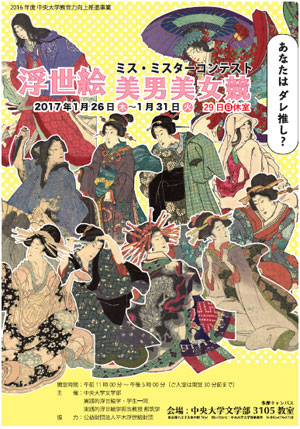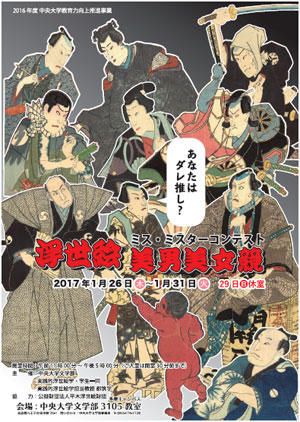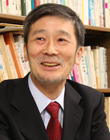Top>Research>The Delights of Ukiyo-e
 Index
Index
The Delights of Ukiyo-e
Manabu Tsuzuki
Professor, Faculty of Letters, Chuo University
Area of Specialization: Developmental Psychology
A new ukiyo-e era
I was still in junior high school when I opened my Nagatanien Ochazuke Nori, dried seaweed seasoning for green tea rice soup and found a card with an ukiyo-e print from The Fifty-Three Stations of the Tokaido by Utagawa Hiroshige. Collecting these cards was a popular thing to do back then, and I was caught up in the trend like everyone else. Unfortunately, my ukiyo-e cards ended up getting lost somewhere, but I heard in the news that Nagatanien brought them back starting with their November 2016 shipments. I’m looking forward to buying some Ochazuke Nori and resuming my hunt for Hiroshige’s prints sometime soon.
About this same time, on November 22, Sumida Hokusai Museum opened in Sumida, Tokyo. Though I’ve only seen it on TV, the building looks quite innovative. I unfortunately missed the inaugural exhibit, “Hokusai Returns: A Long-lost Picture Scroll and Masterpieces from the Collection,” which ran through January 15. It’s really a shame, but I’m committed to finding the time to check out the new museum soon and see what it’s all about.
On the last day of 2016, the morning edition of the Tokyo Shimbun ran an article titled “Scroll Discovered: Could It Be a Hokusai Original?” Titled Chikukeizu [Image of Bamboo and Roosters], the scroll shows two roosters perched atop a stone lantern with bamboo in the background, and is thought to have been painted by Hokusai when he was in his mid-forties. The piece was formerly in the collection of Josiah Conder, the British architect famous for designing the Rokumeikan. I wonder if it will get displayed somewhere, and when it does, I’m eager to go see it in person.
There were actually three stories related to ukiyo-e that came out at the end of last year. Is it just me, or might we be entering a new ukiyo-e era? We weren’t intentionally trying to jump on the same train, but the Faculty of Letters has also recently put together an ukiyo-e exhibit. It’s a bit different than the exhibitions you see in museums, and in this short article, I’d like to tell you a bit about it. I hope you’ll read on.
A student-led ukiyo-e exhibition
The exhibition was part of a Chuo University project to foster academic skills entitled “Active Learning through an Ukiyo-e Exhibition.” I’ve been in charge of spearheading the project. One of its primary objectives is that students will be involved with planning and running an ukiyo-e exhibition.
The project started in last July with opening registration of students for a Faculty of Letters extracurricular program called “Practical Ukiyo-e Studies.” Below is the written overview of the program we used to attract applicants.
This practical workshop gives students an opportunity to host an art exhibition under the guidance of curators who have extensive experience in ukiyo-e exhibitions and who are currently working on the cutting edge of ukiyo-e research. Students will acquire general ukiyo-e knowledge, including historical and genre information, and will even learn how to physically handle and care for exhibition objects. It will be up to the students to discuss and decide on the theme and structure of the art exhibition as well as carry it out. The program gives students an opportunity to handle actual art objects and to research and evaluate works of art. Students will get involved in the real work of an ukiyo-e exhibition, such as proposing an exhibition structure, writing explanatory notes, preparing for the actual displays, and running the event. These activities will give students a deeper understanding of not only the characteristics of the cultural assets but also Japanese history and culture.
A total of ten students signed up for the program, the group ranging from second-year undergraduates to first-year master’s program graduate students. I’m happy to report that thanks to the enthusiasm they showed in their application essays, all ten were accepted. We decided to hold class once a week, starting in the fall term after summer break was over. We brought in Ms. Yoshino Moriyama and Ms. Masako Matsumura, curators at the Hiraki Ukiyo-e Museum (Hiraki Ukiyo-e Foundation), to serve as instructors. These two women are consummate professionals at the top of their field; the students, on the other hand, were essentially blank slates—save for their interest and curiosity about ukiyo-e prints. They had no real knowledge of ukiyo-e nor any experience in art exhibitions. The instructors took the time to carefully explain everything to them, however, and we are deeply grateful for their contributions. We received the prints to be used in the exhibition on loan from the Hiraki Ukiyo-e Museum, thanks to extensive support and understanding from museum director Mitsunobu Sato. There are no words to express our gratitude.
The practical ukiyo-e course consisted of two main parts. The first was acquiring a basic knowledge of ukiyo-e. In addition to learning about the history of ukiyo-e and artist lineages, the students learned how to read the information imprinted on the paintings, such as artist signatures and seals, publisher seals, and seals of approval.
The second part of the course was the work involved in preparing for the exhibition. To start, each student was in charge of preparing reports on three ukiyo-e pieces. The reports started by listing the dimensions (height and width measurements) of the work. They then specified the title, artist, publisher, and publication year. Next, students researched the figures and the landscapes on the piece. This included consulting kabuki chronologies to find out the names of plays and actors. Those information was then used to prepare the captions that would accompany each print in the exhibition.
In the course of performing these tasks, students decided on a theme for the exhibition. This process involved putting forth multiple proposals and reworking them. Ultimately, the students came up with the following theme.
The Ukiyo-e Miss and Mister Contest: Vote for Your Favorites!
Ukiyo-e works will be displayed in two areas, one featuring prints of eleven handsome men and the other featuring prints of eleven beautiful women. Visitors will be given stickers to vote for the most attractive person in each category. The ten students in the program will each be responsible for preparing explanatory notes for one man and one woman. A promotional copy is to be provided for each figure.
The students wrote the title of the exhibition in Japanese, but assigned the English reading “Miss and Mister Contest” to the Chinese characters. The exhibition not only put the ukiyo-e art on display, but also allowed visitors to participate. This ingenious idea was a perfect example of the students bringing their full imaginations and free-thinking spirits to the project.
The students also prepared flyers, posters, and brochures to advertise the event. The guidance of the two curators was also invaluable during this process. Students on the advertising team came up with the basic idea for the flyers and posters, while Ms. Matsumura put the finishing touches on the designs.
The brochure showed an image of each print with its attached commentary. It also included an editorial article. The students on the brochure team came up with this idea. They were each in charge of writing about a different contributor (the engraver, printer, publisher, seal of approval, artist (Utagawa Kunisada/Utagawa Kuniyoshi), actor, etc.). Ms. Moriyama and Ms. Matsumura both reviewed the students’ compositions, offering precise guidance from their expert perspectives.
Now came time to actually put on the exhibition. The explanatory notes were printed and affixed to panels, while mats were cut out to the right size so that the prints could be properly framed and hung. The students laid a plan for how the panels should be arranged and the order in which the prints should be hung. They then hung the framed ukiyo-e prints and explanations on each panel prepared at the exhibition venue. Finally, everything became ready for the day of the exhibition to arrive. The students even divided up reception responsibilities.
As you can see, the practical ukiyo-e course truly lived up to its “active learning” title.
The beauty and possibilities in ukiyo-e
I worked alongside the students in preparation for the exhibition as well. Although I had no prior experience with ukiyo-e, I was able to get a sense of its beauty and possibilities thanks to this project.
The ukiyo-e prints featured in the exhibit were printed from the Edo to Meiji periods. They weren’t all that old—it’s a time in history that’s connected to our modern lives. Still, there is much we don’t know about it. My thoughts began with this most simplistic insight.
We did all kinds of research in the process of preparing the reports, which gradually opened our eyes to things we didn’t know before. It was a fascinating experience. We weren’t just accumulating ukiyo-e trivia; we came to realize that in ukiyo-e there is something that is the foundation for the modern era.
Today everything strives to be “global,” a word that encompasses our entire world. But I wonder if we’re not making a mistake by focusing exclusively outward. Are we not paying a price for remaining ignorant of our own roots? These thoughts have also grown stronger through my experience with the project.
I’ve come to see ukiyo-e as a mirror that allows us to reassess our modern way of life, one in which we are constantly striving to be more rational, economical, and efficient.
The students brought their creative ingenuity to this ukiyo-e exhibition, and I urge you to go see it. Perhaps it will give you an opportunity to experience the beauty and possibilities of ukiyo-e.
The Ukiyo-e Miss and Mister Contest: Vote for Your Favorites!
When: Thursday January 26 through Tuesday, January 31, 11AM–5PM
(closed on Sunday, January 29)
Where: Chuo University Tama Campus, Building No. 3 (Faculty of Letters Building), Room 3015
Admission: Free


- Manabu Tsuzuki
Professor, Faculty of Letters, Chuo University
Area of Specialization: Developmental Psychology - Manabu Tsuzuki was born in Tokyo in 1951. He graduated from the Faculty of Education, Tokyo University of Education, and later from the master’s program at its Graduate School of Education. He withdrew from the doctoral program at the Graduate School of Psychology, University of Tsukuba after completing the required course work and has a doctorate in education.
Tsuzuki served as a fulltime lecturer and associate professor at Ogaki Women’s College and an associate professor on the Faculty of Letters, Chuo University before assuming his current position in 1994.
He was the Dean of the Graduate School of Letters, Chuo University from November 2009 to October 2013, and has been the Dean of the university’s Faculty of Letters since November 2013. -
Research topics
Manabu Tsuzuki has been studying time perspectives since around 1980. Between 1997 and 2011, he used a longitudinal study to explore the process by which time perspectives change along with environmental transitions, publishing his findings. His publications include: University Students’ Career Choice and Time Perspective [Daigakusei no Shinro Sentaku to Jikanteki-Tenbo] (Nakanishiya Shuppan, 2007); School Transition from Elementary to Junior High School and Time Perspective [Shogakko kara Chugakko e no Gakko Iko to Jikanteki-Tenbo] (Nakanishiya Shuppan, 2008); School Transition from Junior High to High School and Time Perspective [Chugakko kara Koko e no Gakko Iko to Jikanteki-Tenbo] (Nakanishiya Shuppan, 2009); and High School Students’ Career Choice and Time Perspective [Kokosei no Shinro Sentaku to Jikanteki-Tenbo] (Nakanishiya Shuppan, 2014. Last year, Tsuzuki published his tenth single-authored work, How to Write a Good Report: A Handbook for First-year University Students [Daigaku Ichinensei no tame no tsutawaru Repoto no Kakikata] (Yuhikaku Publishing, 2016)
- Research Activities as a Member of Research Fellowship for Young Scientists (DC1), Japan Society for the Promotion of Science (JSPS) Shuma Tsurumi
- Important Factors for Innovation in Payment Services Nobuhiko Sugiura
- Beyond the Concepts of Fellow Citizens and Foreigners— To Achieve SDGs Goal 10 “Reduce Inequality Within and Among Countries” Rika Lee
- Diary of Struggles in Cambodia Fumie Fukuoka
- How Can We Measure Learning Ability?
—Analysis of a Competency Self-Assessment Questionnaire— Yu Saito / Yoko Neha - The Making of the Movie Kirakira Megane









